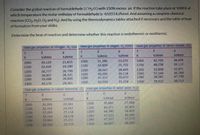
Introduction to Chemical Engineering Thermodynamics
8th Edition
ISBN: 9781259696527
Author: J.M. Smith Termodinamica en ingenieria quimica, Hendrick C Van Ness, Michael Abbott, Mark Swihart
Publisher: McGraw-Hill Education
expand_more
expand_more
format_list_bulleted
Concept explainers
Question
thumb_up100%
Pls do Asap...!

Transcribed Image Text:Consider the global reaction of formaldehyde (CH20) with 150% excess air. If the reaction take place at 1000 k at
which temperature the molar enthalpy of formaldehyde is -81053 kJ/kmol. And assuming a complete chemical
reaction (CO2, H,O, 02 and Na). And by using the thermodynamics tables attached if necessary and the table of heat
of formation from your slides.
Determine the heat of reaction and determine whether this reaction is endothermic or exothermic
Ideal-gas properties of nitrogen, N, (Cor Ideal-gas properties of axygen, 0, (Concl Ideal-gas properties of carbon dioxide, CO,
T.
K
K/kmol
kJ/kmol
K
kkmol
k/kmol
K
Kkmol
kJ/kmot
31,389
34,899
23,075
25,753
42,769
48,258
34,455
39,112
1000
30,129
21,815
1000
1000
1100
1100
1100
33,426
24,280
1200
1260
1280
53,848
57,244
58,381
43,871
36,777
38,807
39,488
40,170
26,799
28,331
28,845
1200
1260
1280
1300
38,447
40,594
41,312
42,033
28,469
30,118
30,670
31,224
1200
46,768
47,739
1260
1280
1300
59,522
48,713
1300
29,361
Ideel-gas properties of carbon monoxide, Co Ideal-gas properties or water vapor, HO
K.
kJ/kmol
kikmol
K
kkmol
Kkmot
27,568
35,882
40,071
44 380
47,022
47.912
1000
22,041
24,557
30,355
33,702
37,095
39,154
39,844
40,534
1000
30.925
34 403
36,546
37,270
38.000
1100
1200
1100
1200
1260
1280
27,118
28,678
29,201
29,725
1260
1280
300
1300
48.807
Expert Solution
This question has been solved!
Explore an expertly crafted, step-by-step solution for a thorough understanding of key concepts.
This is a popular solution
Trending nowThis is a popular solution!
Step by stepSolved in 4 steps

Knowledge Booster
Learn more about
Need a deep-dive on the concept behind this application? Look no further. Learn more about this topic, chemical-engineering and related others by exploring similar questions and additional content below.Similar questions
- can you type this out in word using the equation function i cant understand this at allarrow_forwardwhat are the ethics for chemical engineering, and then say the safety rules for chemical engineeringarrow_forwardStuck need help! Problem is attached. please view attachment before answering. Really struggling with this concept. Please show all work so I can better understand ! Thank you so much.arrow_forward
arrow_back_ios
arrow_forward_ios
Recommended textbooks for you
 Introduction to Chemical Engineering Thermodynami...Chemical EngineeringISBN:9781259696527Author:J.M. Smith Termodinamica en ingenieria quimica, Hendrick C Van Ness, Michael Abbott, Mark SwihartPublisher:McGraw-Hill Education
Introduction to Chemical Engineering Thermodynami...Chemical EngineeringISBN:9781259696527Author:J.M. Smith Termodinamica en ingenieria quimica, Hendrick C Van Ness, Michael Abbott, Mark SwihartPublisher:McGraw-Hill Education Elementary Principles of Chemical Processes, Bind...Chemical EngineeringISBN:9781118431221Author:Richard M. Felder, Ronald W. Rousseau, Lisa G. BullardPublisher:WILEY
Elementary Principles of Chemical Processes, Bind...Chemical EngineeringISBN:9781118431221Author:Richard M. Felder, Ronald W. Rousseau, Lisa G. BullardPublisher:WILEY Elements of Chemical Reaction Engineering (5th Ed...Chemical EngineeringISBN:9780133887518Author:H. Scott FoglerPublisher:Prentice Hall
Elements of Chemical Reaction Engineering (5th Ed...Chemical EngineeringISBN:9780133887518Author:H. Scott FoglerPublisher:Prentice Hall
 Industrial Plastics: Theory and ApplicationsChemical EngineeringISBN:9781285061238Author:Lokensgard, ErikPublisher:Delmar Cengage Learning
Industrial Plastics: Theory and ApplicationsChemical EngineeringISBN:9781285061238Author:Lokensgard, ErikPublisher:Delmar Cengage Learning Unit Operations of Chemical EngineeringChemical EngineeringISBN:9780072848236Author:Warren McCabe, Julian C. Smith, Peter HarriottPublisher:McGraw-Hill Companies, The
Unit Operations of Chemical EngineeringChemical EngineeringISBN:9780072848236Author:Warren McCabe, Julian C. Smith, Peter HarriottPublisher:McGraw-Hill Companies, The

Introduction to Chemical Engineering Thermodynami...
Chemical Engineering
ISBN:9781259696527
Author:J.M. Smith Termodinamica en ingenieria quimica, Hendrick C Van Ness, Michael Abbott, Mark Swihart
Publisher:McGraw-Hill Education

Elementary Principles of Chemical Processes, Bind...
Chemical Engineering
ISBN:9781118431221
Author:Richard M. Felder, Ronald W. Rousseau, Lisa G. Bullard
Publisher:WILEY

Elements of Chemical Reaction Engineering (5th Ed...
Chemical Engineering
ISBN:9780133887518
Author:H. Scott Fogler
Publisher:Prentice Hall


Industrial Plastics: Theory and Applications
Chemical Engineering
ISBN:9781285061238
Author:Lokensgard, Erik
Publisher:Delmar Cengage Learning

Unit Operations of Chemical Engineering
Chemical Engineering
ISBN:9780072848236
Author:Warren McCabe, Julian C. Smith, Peter Harriott
Publisher:McGraw-Hill Companies, The